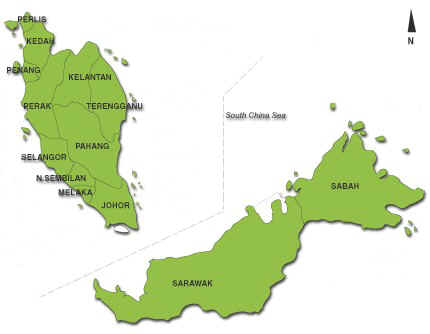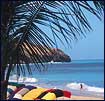Malaysia consists of 13 States and the Federal Territories of Kuala Lumpur, Putrajaya and Labuan which is an island off the coast of Sabah over in East Malaysia. Of the total population of Malaysia in Census 2000, about 21,890 thousand or 94.1% were Malaysian citizens. Of the total Malaysian citizens, 'Bumiputera' (Malay and native indigenous groups) comprised 65.1%, Chinese 26.0% and Indians 7.7%, the ethnic composition being 60.6%, 28.1% and 7.9% respectively in 1991. Non-Malaysian citizens totalled 1,385 thousand (or 5.9%) in Census 2000 as against 805 thousand (or 4.4%) in 1991
Population Distribution
In terms of population distribution by state in Census 2000, Selangor was the most populous state (4.19 million) followed by Johor (2.74 million) and Sabah (2.60 million). Their share of the total population of Malaysia was 18.0%, 11.8% and 10.6% respectively. The least populated states were Wilayah Persekutuan Labuan (0.08 million or 0.3%) and Perlis (0.20 million or 0.9%).
|
PERLIS |
The smallest state in Malaysia. The majority of its people are Malay (78%), followed by Chinese (17%), The economy is based on rice, rubber and fishing |
|
KEDAH |
The rice bowl state. The majority of the people are Malay (72%), followed by Chinese (19%) and Indians (8%) with a million plus population. Kedah is Malaysia's oldest state. The ruling family traces its origins to Hindu times, and is the only state that still has ruins from that period. |
|
PENANG |
The state occupies an island and a part of the mainland. The Chinese (55%) are the majority of the population at over a million with Malays (33%) and Indians (11%) |
|
PERAK |
The Second largest state in Peninsula Malaysia, it was once the richest state during the tin boom and Ipoh was known as the city of millionaires. This is no longer the case since the world wide drop in tin prices. With a population of a little more than 2 million, the percentage of Malays (45%) and Chinese (41%) are almost the same. There is also quite a few Indians (14%). |
|
SELANGOR |
Selangor is the state that surrounds the Federal Territory of Kula Lumpur and Putrajaya. Total population of above 2 million, composed of 44% Malays, 35% Chinese and 18% Indians. The Klang Valley is a big industrial centre containing the cities of Petaling Jaya, Shah Alam (its capital), Klang and Port Klang, the second largest port in Malaysia. |
|
PUTRAJAYA |
Malaysia's new administrative capital, A metropolis of landscaped gardens and domed buildings is Malaysia's third federal territory after KL and Labuan.
This new city will ultimately provide for an approximately 330,000 people and will function as the principal seat of government. It will be served by advanced communications and transportation infrastructure |
|
KUALA LUMPUR |
The Federal Territory of Kuala Lumpur, a modern, bustling city of well over 1.8 million people. Whereas ethnic Malays are in the majority nationally, ethnic Chinese constitute the predominant group in KL, although the city also has a large Malay population and a substantial ethnic Indian minority. |
|
NEGERI SEMBILAN |
Negeri Sembilan is practically an inland state with only 48km of coastline. It has a population of about 757,000 of whom 46% are Malay, 36% are Chinese and 17% are Indian. The state is set on industrialisation as its agriculture had already been fully developed. Rice, cocoa, oil palm, rubber trees, livestock and fish (including shrimp are all raised here). |
|
MELAKA |
With a population of 75,000 of whom 54% are Malay, 36% are Chinese and 8% are Indians. The state is industrialising rapidly. Noted for its history and remnants of its past colonisers. |
|
JOHOR |
The southernmost state on the peninsula, it has a population of about 2 million, consisting of 55% Malays, 36% Chinese and only 6% Indians. Johor is a leading agricultural state, especially rubber, palm oil and pineapples. Johor is Industrialising rapidly, its proximity to Singapore is a big factor. |
|
KELANTAN |
With a population of about 1 million, it has the highest percentage of Malays with 93%. Chinese make-up only 5% and Indians only 1%. The people are mostly rice and tobacco farmers. Other products include rubber, palm oil, coconuts and fruit. Fishing is also an important industry. Kelantan is well known for traditional Malay handiwork, silverwork, brocade, batik etc. |
|
TERENGGANU |
The most Malay of all the states. The population of about 750,000 is 94% Malay and 5% Chinese. People earn their living from fishing, boat building (for which they are famous), coconuts and rubber. Though it is the least developed state in the peninsula, the discovery of oil and gas along its coast is changing the landscape dramatically. |
|
SABAH |
Though Sabah is among the most expensive places in South East Asia, the land has much to offer. Sabah is primarily mountainous. Oil as well as mineral resources makes the state an important player in the Malaysian economy. another important economic product is timber Though Islam is practiced by Malays and Bajau, Christianity is also more widespread here with adherents from the Kadazan. With a population of about 1.25 million, here the Malays are a real minority with only 8%, 63% are from various indigenous ethnic groups and the remainder are from other groups, primarily Indians and Chinese. the predominant ethnic group being the Kadazan Dusun (18.4%) followed by Bajau (17.3%) and Malays (15.3%) |
|
SARAWAK |
The largest Malaysian state, it has a population of about 2.3 million with 40% living in the 3 big cities of Kuching Sibu and Miri. The remainder of the population lives in the countryside or in the jungle. The economy of the state is mainly oil and gas, timber and peper. Islam is not very widespread and is limited mostly to the large towns. In the interior, many of the people are Christians and some still practicing Animism'. The predominant ethnic group in Census 2000 was the Ibans which accounted for 30.1% of the state's total Malaysian citizens followed by the Chinese (26.7%) and Malays (23.0%) |
|
LABUAN |
Formerly part of Sabah, In 1984 it was separated from Sabah and given the status of a federal territory. With her free port status, Labuan, economically speaking was a 'sleeping beauty' with growth taking place after becoming a Federal Territory. The population of Labuan is about 78,000 comprising of 41,900 males and 36,100 females. Malay - 24,400, Chinese - 9,400, Indian - 900, with Other races - 20,900, and Foreigners - 22,400 |
Tours
 |


